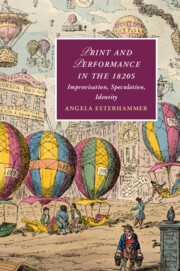Book contents
- Print and Performance in the 1820s
- Cambridge Studies in Romanticism
- Print and Performance in the 1820s
- Copyright page
- Contents
- Illustrations
- Acknowledgements
- Chapter 1 Introduction: Being There, circa 1824
- Chapter 2 Periodical Performances
- Chapter 3 Mediating Improvisation and Improvising Mediation
- Chapter 4 Personal Identity, Impersonation, and Charles Mathews
- Chapter 5 Theodore Hook’s Sayings and Doings on the Page and the Stage
- Chapter 6 Speculating on Property
- Chapter 7 Scottish Fictions of 1824
- Notes
- Bibliography
- Index
- Cambridge Studies in Romanticism
Chapter 1 - Introduction: Being There, circa 1824
Published online by Cambridge University Press: 11 March 2020
- Print and Performance in the 1820s
- Cambridge Studies in Romanticism
- Print and Performance in the 1820s
- Copyright page
- Contents
- Illustrations
- Acknowledgements
- Chapter 1 Introduction: Being There, circa 1824
- Chapter 2 Periodical Performances
- Chapter 3 Mediating Improvisation and Improvising Mediation
- Chapter 4 Personal Identity, Impersonation, and Charles Mathews
- Chapter 5 Theodore Hook’s Sayings and Doings on the Page and the Stage
- Chapter 6 Speculating on Property
- Chapter 7 Scottish Fictions of 1824
- Notes
- Bibliography
- Index
- Cambridge Studies in Romanticism
Summary
The introductory chapter examines recurring themes in the literary-cultural field of the 1820s: improvisation, speculation, and personal identity. A multivalent notion of performance functioned as a kind of “media concept” during the late-Romantic period, an era characterized by the interwoven evolution of print media and theatrical genres. In order to define the sphere of metropolitan, bourgeois, market–facing culture that was a driving force of the late-Romantic literary field, this chapter focuses on the exemplary year 1824 – a high point for performances of theatrical improvisation and for financial speculation, and a year that saw an extraordinary conjunction of trend-setting productions by William Hazlitt, Tommaso Sgricci, Charles Mathews, Theodore Hook, Mary Russell Mitford, John Galt, Walter Scott, and Lord Byron. An emphasis on the improvisational and speculative nature of writing, acting, and publishing generates a new paradigm for understanding the 1820s as an “age of information” as well as a self-reflective “age-in-formation.”
- Type
- Chapter
- Information
- Print and Performance in the 1820sImprovisation, Speculation, Identity, pp. 1 - 27Publisher: Cambridge University PressPrint publication year: 2020



